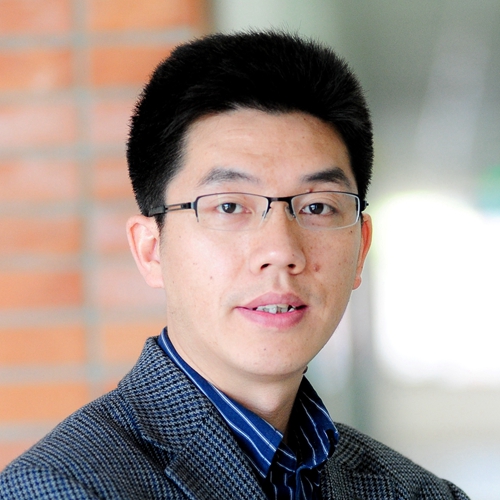 |
教授,清华-IDG/麦戈文脑科学研究院
教授,清华大学药学院
教授,清华-北大生命联合中心
办公电话:86-10-6277 3981
实验室电话:86-10-6277 3952 电子邮件: xbailong@biomed.tsinghua.edu.cn |
[研究兴趣]
离子通道是控制细胞兴奋性和其它功能的一类重要跨膜蛋白。遗传突变或生理调节性紊乱所导致的离子通道功能失调可以致使包括神经疾病、心血管病、免疫疾病及代谢疾病等在内的很多重大疾病(统称为离子通道病)。因而,对于离子通道的结构和功能的研究不仅有助于我们了解这一类重要蛋白,并有助于相关新药或新疗法的设计开发。
我们实验室综合利用分子生物学、生物化学、结构生物学、生物物理学、神经生物学、钙成像技术、电生理、基因敲除小鼠的建立和行为学测试、高通量靶点或药物筛选等研究手段,着重开展温度门控型以及机械力门控型离子通道(例如机械力门控Piezo离子通道)的鉴定发现、结构功能关系以及生理学和病理学意义的研究。这类被称之为感受性的离子通道可以作为包括温度、化学物质及其机械力等触觉刺激的受体从而对控制我们五感之一的触觉的发生和调控以及其它机械力传感生理过程具有极其重要的作用。通过对这些离子通道的研究,我们期望能对触觉和痛觉的分子生物学机制以及机械力传感在其它生理过程中的作用能有更好的了解,并期望最终能开发出以这些通道为靶点的新型药物。
实验室目前的主要研究方向包括:
1)机械门控Piezo离子通道结构功能、生理/病理学意义、药物筛选;
2)STIM1/Orai离子通道温度敏感性的生理学意义;
2)STIM1/Orai离子通道温度敏感性的生理学意义;
3)签定发现新型机械门控或温度门控离子通道或受体。
[简历]
2021–至今 清华大学药学院教授,清华-北大生命联合中心教授
2021-至今 清华-IDG/麦戈文脑科学研究院教授
2021-至今 清华-IDG/麦戈文脑科学研究院教授
2013–2021 清华大学药学院研究员,清华-北大生命联合中心研究员
2013–2021 清华-IDG/麦戈文脑科学研究院研究员
2007–2012 美国Scripps研究院博士后
2007–2012 美国诺华研究基金会的基因组研究所访问学者
2001–2006 加拿大卡尔加里大学心血管和呼吸系统科学博士
2013–2021 清华-IDG/麦戈文脑科学研究院研究员
2007–2012 美国Scripps研究院博士后
2007–2012 美国诺华研究基金会的基因组研究所访问学者
2001–2006 加拿大卡尔加里大学心血管和呼吸系统科学博士
1997–2001 中山大学生物化学学士
[部分发表]
- Qiancheng Zhao, Heng Zhou, Shaopeng Chi, Yanfeng Wang, Jianhua Wang, Jie Geng, Kun Wu, Wenhao Liu, Tingxin Zhang, Meng-Qiu Dong, Jiawei Wang, Xueming Li*, Bailong Xiao*(2018) Structure and Mechanogating Mechanism of the Piezo1 Channel. Nature (Article) 2018 Feb 22;554(7693):487-492. doi: 10.1038/nature25743. Epub 2018 Jan 22.
- Yanfeng Wang, Shaopeng Chi, Huifang Guo, Guang Li, Li Wang, Qiancheng Zhao, Yu Rao, Liansuo Zu, Wei He, Bailong Xiao* (2018) A lever-like transduction pathway for long-distance chemical- and mechano-gating of the mechanosensitive Piezo1 channel. Nat Commun 2018 Apr 04.
- Tingxin Zhang, Shaopeng Chi, Fan Jiang, Qiancheng Zhao, Bailong Xiao* (2017). A protein interaction mechanism for suppressing the mechanosensitive Piezo channels. Nat Commun. 2017 Nov 27;8(1):1797.?
- Yubo Wang, Bailong Xiao* (2017). The mechanosensitive Piezo1 channel: structural features and molecular bases underlying its ion permeation and mechanotransduction. J Physiol. 2018 Mar 15;596(6):969-978.
- Jie Geng, Qiancheng Zhao, Tingxing Zhang, Bailong Xiao* (2017). In Touch With the Mechanosensitive Piezo Channels: Structure, Ion Permeation and Mechanotransduction. Curr Top Membr. 2017;79:159-195.
- Qiancheng Zhao, Kun Wu, Jie Geng, Shaopeng Chi, Yanfeng Wang, Peng Zhi, Mingmin Zhang, Bailong Xiao*(2016). Ion Permeation and Mechanotransduction Mechanisms of Mechanosensitive Piezo Channels. Neuron. 2016 Mar 16;89(6):1248-63.
- Jingpeng Ge, Wanqiu Li, Qiancheng Zhao, Ningning Li, Maofei Chen, Peng Zhi, Ruochong Li, Ning Gao*, Bailong Xiao*, Maojun Yang(2015). Architecture of the mammalian mechanosensitive Piezo1 channel. Nature. Nov 5;527(7576):64-9.
- Bertrand Coste*, Bailong Xiao*, Jose S. Santos, Ruhma Syeda, Jorg Grandl, Kathryn S. Spencer, Sung Eun Kim, Manuela Schmidt, Jayanti Mathur, Adrienne E. Dubin, Mauricio Montal, Ardem Patapoutian (2012). Piezo Proteins Are Pore-forming Subunits of Mechanically Activated Channels. Nature. 2012 Feb 19;483(7388):176-81 PMID:22343900.
- Bailong Xiao*, Bertrand Coste, Jayanti Mathur, Ardem Patapoutian (2011). Temperature-dependent STIM1 activation induces Ca2+ influx and modulates gene expression. Nat Chem Biol. 2011 Jun;7(6):351-8. PMID: 21499266.
- Bailong Xiao*, Ardem Patapoutian (2011). Scratching the surface: a role of pain-sensing TRPA1 in itch. Nat Neurosci. 2011 May;14(5):540-2. PMID: 21522144 News & Views
- Bailong Xiao*, Adrienne E. Dubin, Badry Bursulaya, Veena Viswanath, Timothy J. Jegla, Ardem Patapoutian (2008). Identification of Transmembrane Domain Five as a Critical Molecular Determinant of Menthol Sensitivity in Mammalian TRPA1 Channels. J Neurosci. 2008 Sep 24;28(39):9640-51.
- Lindsey J. Macpherson*, Bailong Xiao*, Kelvin Y. Kwan (co-first), Matt J. Petrus, Adrienne E. Dubin, SunWook Hwang, Benjamin Cravatt, David P. Corey, Ardem Patapoutian (2007). An Ion Channel Essential for Sensing Chemical Damage. J Neurosci. 2007 Oct 17;27(42):11412-5.
- Bailong Xiao*, Xixi Tian, Wenjun Xie, Peter P. Jones, Shitian Cai, Xianhua Wang, Dawei Jiang, Lin Zhang, Keyun Chen, Michael P. Walsh, Heping Cheng, and S. R. Wayne Chen (2007). Functional Consequence of PKA-dependent Phosphorylation of the Cardiac Ryanodine Receptor: Sensitization of Store-overload-induced Ca2+ release (SOICR). J Biol Chem. 2007 Aug 10.
- Bailong Xiao*, Guofeng Zhong, Masakazu Obayashi, Dongmei Yang, Michael P. Walsh, Yakhin Shimoni, Heping Cheng, Henk ter Keurs, and S. R. Wayne Chen (2006). Serine-2030, but not Serine-2808, is the Major RyR2 Phosphorylation Site Responding to PKA Activation upon beta-adrenergic Stimulation in Normal and Failing Hearts. Biochem J. 2006 Feb 17.
- Bailong Xiao*, Ming Tao Jiang, Mingcai Zhao, Dongmei Yang, Cindy Sutherland, F. Anthony Lai, Michael P. Walsh, Heping Cheng, David C. Warltier, and S. R. Wayne Chen (2005). Characterization of a Novel Protein Kinase A Phosphorylation Site, Serine-2030, Reveals No PKA Hyperphosphorylation of the Cardiac Ryanodine Receptor in Canine Heart Failure. Circ Res. 2005 Apr 29;96(8):847-55.
- Bailong Xiao*, Cindy Sutherland, Michael P. Walsh, S. R. Wayne Chen (2004). Protein Kinase A Phosphorylation at Serine-2808 of the Cardiac Ca2+-Release Channel (Ryanodine Receptor) Does Not Dissociate 12.6-kDa FK506-Binding Protein (FKBP12.6). Circ Res. 2004 Mar 5;94(4):487-95.
- Bailong Xiao*, Haruko Masumiya, Dawei Jiang, Ruiwu Wang, Yoshitatsu Sei, Lin Zhang, Takashi Murayama, Yasuo Ogawa, F. Anthony Lai, Terence Wagenknecht, and S. R. Wayne Chen (2002). Isoform Dependent Formation of Heteromeric Ca2+ Release Channels (Ryanodine Receptors). J Biol Chem. 2002 Nov 1; 277(44): 41778-85.
